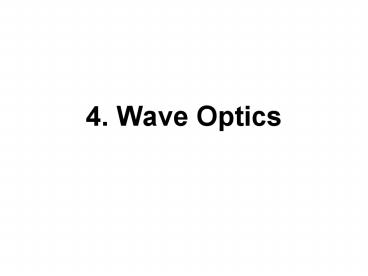4. Wave Optics - PowerPoint PPT Presentation
1 / 58
Title:
4. Wave Optics
Description:
4. Wave Optics Spherical Wave, Image Formation, and Huygens Principle Linear Polarization Circular/Elliptical Polarization Unpolarized Light and Polarizer Liquid ... – PowerPoint PPT presentation
Number of Views:172
Avg rating:3.0/5.0
Title: 4. Wave Optics
1
4. Wave Optics
2
Spherical Wave, Image Formation, and Huygens
Principle
Wavefront a surface over which the phase of a
wave is constant
Huygens Principle
3
Linear Polarization
4
Circular/Elliptical Polarization
5
Unpolarized Light and Polarizer
6
Liquid Crystal Display (LCD)
7
3D Imaging by Polarizers
8
- Reflection and Transmittance of Polarized Lights
Note p-polarization E-field ?? plane of
incidence s-polarization E-field ? plane of
incidence
9
Goos-Haenchen Shift
10
Optical Transfer Matrix to Analyze Three-layer
Film
11
Optical Transfer Matrix to Analyze Three-layer
Film (Cont)
12
Antireflection Film
Antireflection Coatings on Solar Cells
13
High-reflectance Film
14
High-reflectance Film (Cont)
15
Interference
Youngs Experiment
- Interference superposition of two light wave
result in bright and dark fringes - Conditions for Interference
- same polarization
- same frequency
- constant phase relationship (coherence)
16
- Conditions for Interference
If ?1 ?2 ?
17
Fabry-Perot Interferometer
18
Fabry-Perot Interferometer (Cont)
19
Fabry-Perot Interferometer (Cont)
GaAss natural cleavage plane is (1,1,0)-plane.
Sis and Ges natural cleavage plane are
(1,1,1)-plane.
20
Mach-Zehnder Interferometer
21
Holography/Hologram
22
3D Hologram Videos
23
Michelson Interferometer
24
Sagnac Effect and Ring Interferometer
- N Fringe number
25
Interferences of Coherent/Incoherent Waves
- Coherence All component electromagnetic waves
are in phase or in the same phase difference. - Interference of coherent waves Waves of
different frequencies interfere to form a pulse
if they are coherent. - Interference of incoherent waves Spectrally
incoherent light interferes to form continuous
light with a randomly varying phase and
amplitude.
26
Fresnel (Near-field) Diffraction
27
Fraunhofer (Far-field) Diffraction
28
Fraunhofer Diffraction Pattern of a Rectangular
Aperture
29
Fraunhofer Diffraction Pattern of a Circular
Aperture
30
Resolving Power of Imaging Systems
Rayleigh criterion
31
Resolution Limit
- Rayleigh criterion ? two object point can be
resolved by the lens of an optical system
32
Resolution of Human Eye
Resolving power of human eye ? 0.3
mrad Resolution limit of human eye ? 0.075mm
33
Fourier Transform by a Convex Lens
34
- Optical Fourier Transform
35
Optical Signal Processing
36
Examples of Optical Signal Processing
37
Examples of Optical Signal Processing (Cont)
38
Fourier Optics and Its applications
- Optical Computing
39
Phase Contrast Microscopy
40
Appendix 4-1 Coherence
41
Coherence Function
Mutually coherent point sources u1(t1, x1, y1,
z1) and u2(t1, x2, y2, z2 ) maintain a fixed
phase relation Mutual coherence function
Normalized mutual coherence function (complex
degree of coherence or degree of correlation)
where ?11(?) and ?22(?) are the self-coherence
functions of u1(t) and u2(t)
42
- Demonstration of Coherence
extended source
interference pattern
If I1 I2 I (best condition), ? ? ?12(?)
? i.e., visibility of the fringe is a measure of
the degree of coherence
43
- Spatial Coherence
extended source
Intensity distribution of the resultant fringe of
two points on the extended source
extended source
44
Measurement of Spatial Coherence
45
Temporal Coherence
Visibility of the fringe is a measure of the
degree of temporal coherence ?11(?) at same point
Coherence length of the light source
46
Measurement of Temporal Coherence
47
Appendix 4-2 Fourier Transform
48
Fourier Transform Pairs
49
Basic Theorems of Fourier Transforms
50
Basic Theorems of Fourier Transforms (Cont)
51
(No Transcript)
52
(No Transcript)
53
(No Transcript)
54
Application of Fourier Transform-Distinguishing
Similar Signals
55
Appendix 4-3 Phase Transform Function of a Lens
56
Usage of a Thin Lens? Phase Transformation
57
Phase Transform Function of a Lens
58
Phase Transform Function of a Lens

